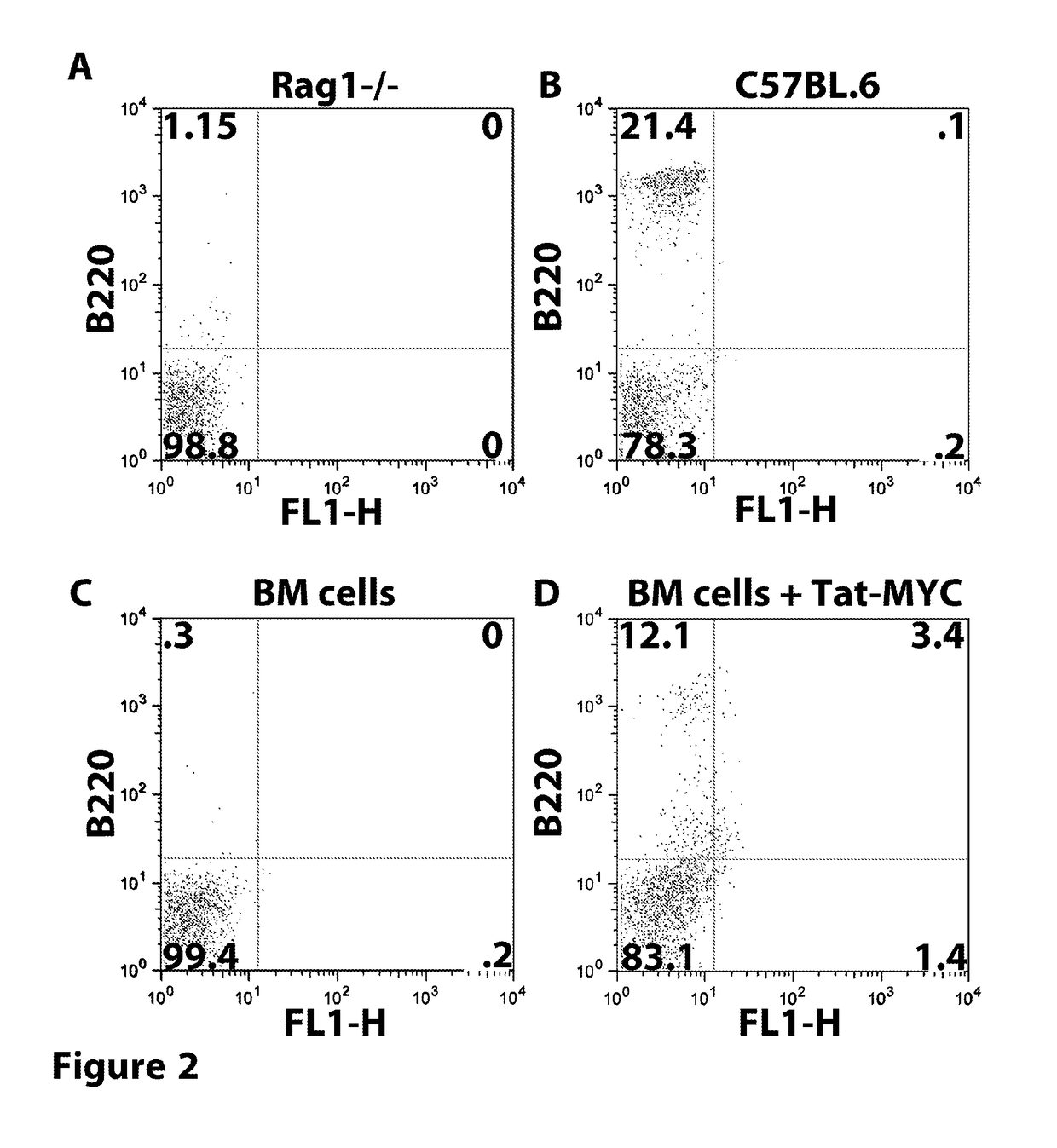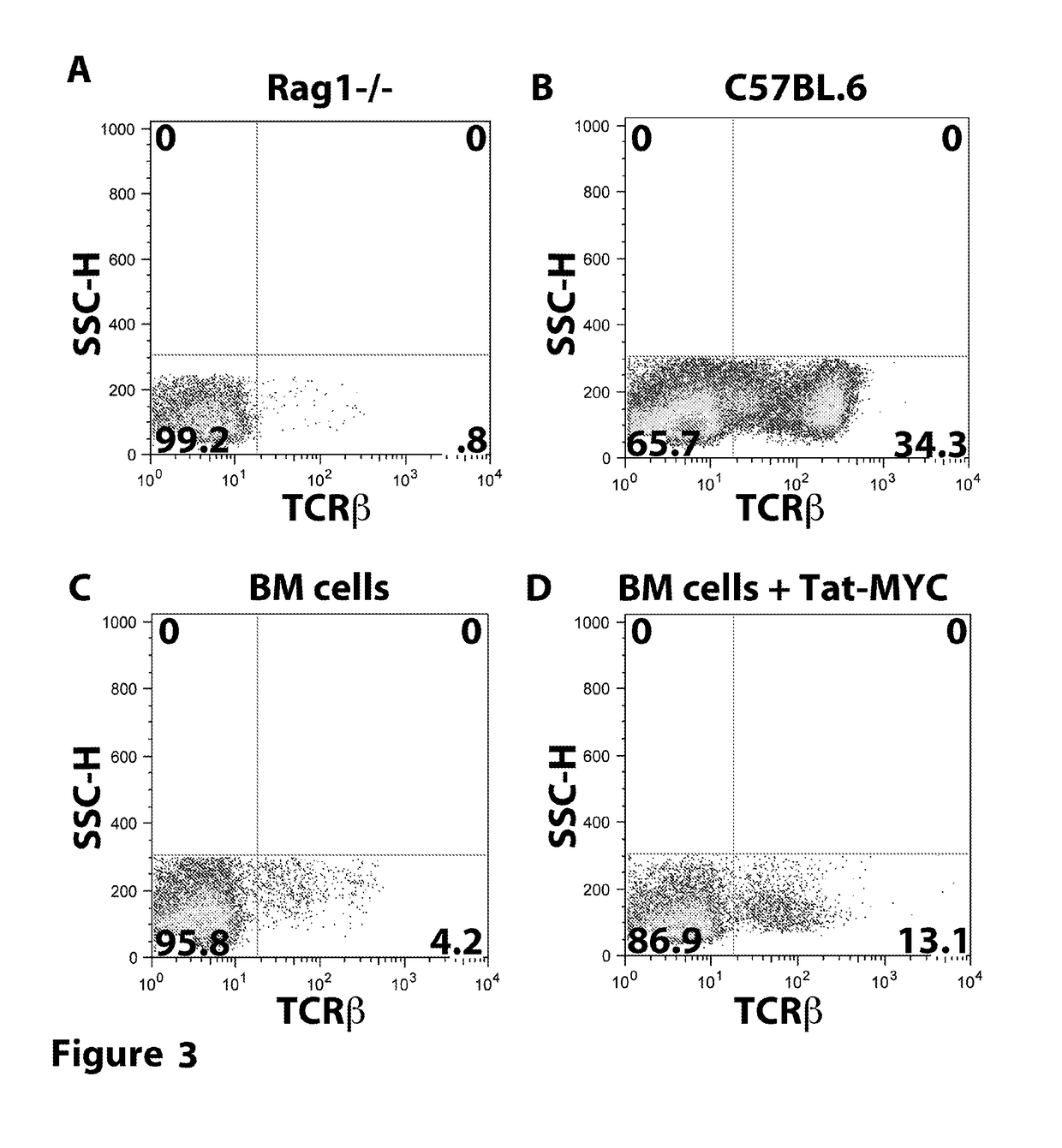Enhanced reconstitution and autoreconstitution of the hematopoietic compartment
a hematopoietic compartment and autologous technology, applied in the direction of peptides, drug compositions, immunological disorders, etc., can solve the problems of limited therapeutic application of hematopoietic stem cell (hsc) transplantation, limited hsc transplantation therapy application, low number of hscs available for transplantation, etc., to enhance hematopoietic compartment autologous
- Summary
- Abstract
- Description
- Claims
- Application Information
AI Technical Summary
Benefits of technology
Problems solved by technology
Method used
Image
Examples
example 1
ed Hematopoietic Reconstitution in Mice
[0273]The following example describes the results of treating mice with a TAT-MYC fusion protein after transplantation with expanded bone marrow cells (e.g. protein transduced longterm hematopoietic stem cells (ptlt-HSCs)).
Materials and Methods
[0274]Cohorts of 4-6 week old female C57BL / 6J mice were obtained from Jackson Laboratories (Bar Harbor, Me.). The mice were treated with 5 mg / mouse of 5-fluorouracil (5FU), intravenously. Bone marrow (BM) cells were collected from the tibia and femur bones 5 days after 5FU treatment. The red blood cells were lysed by incubation in 5 ml sterile TAC buffer (135 mM NH4CL, 17 mM Tris Ph 7.65). The bone marrow cells were expanded in BM Medium (DMEM containing 15% FCS, 100 units per ml Penn / Strep, MEM NEAA (Gibco), 10 mM HEPES, recombinant murine IL-3, IL-6, and SCF) supplemented with 5 μg / ml recombinant Tat-Myc, and 10 μg / ml recombinant Tat-Bcl-2. Cells were cultured for 21 days with a BM medium change every 4...
example 2
ed Hematopoietic Reconstitution in Mice
[0283]The following example describes the results of treating mice with a TAT-MYC fusion protein following freshly isolated whole bone marrow transplantation.
Materials and Methods
[0284]For whole bone marrow transplantations in mice, donors and recipients were both on a C57 / BL6 background.
[0285]Bone marrow cells were flushed from femurs and tibial bones obtained from two donor wild type C57 / BL6 mice. The harvested cells were transferred into D10 complete medium (DMEM supplemented with 10% heat inactivated fetal calf serum, 100 units / ml penicillin / streptomycin, 10 μg / ml L-glutamine, as well as MEM NEAA). The bone marrow aspirates were dissociated into single cell suspensions and pelleted by centrifugation. The red blood cells were lysed by incubation of the cell suspension in a hypotonic buffer (135 mM NH4Cl, 17 mM Tris, pH 7.65). The remaining cells were then washed in D10 medium followed by two washes with PBS and kept cold until transplantatio...
example 3
of Hematopoietic Reconstitution in Mice Treated with 5-Fluorouracil
[0298]The following example describes the results of treating mice with a TAT-MYC fusion protein after administration of 5-fluorouracil (5-FU), a chemotherapeutic agent known to be toxic to the hematopoietic compartment.
Introduction
[0299]Current approaches for reversing bone marrow failure that arises from various environmental insults or disease, among others, basically rely on the administration of growth factors and red blood cell transfusions for supportive therapy. The ultimate goal of these approaches is to encourage the remaining endogenous HSCs to mobilize and repopulate the hematopoietic compartment (auto-reconstitution). However, the current approaches are inefficient and in many cases simply delay the requirement for a myeloablative bone marrow transplant.
[0300]In addition, the sensitivity of HSCs to chemotherapeutic drugs as well as radiation has historically limited the doses of each therapy that can be ...
PUM
| Property | Measurement | Unit |
|---|---|---|
| time | aaaaa | aaaaa |
| time | aaaaa | aaaaa |
| time | aaaaa | aaaaa |
Abstract
Description
Claims
Application Information
 Login to View More
Login to View More - R&D
- Intellectual Property
- Life Sciences
- Materials
- Tech Scout
- Unparalleled Data Quality
- Higher Quality Content
- 60% Fewer Hallucinations
Browse by: Latest US Patents, China's latest patents, Technical Efficacy Thesaurus, Application Domain, Technology Topic, Popular Technical Reports.
© 2025 PatSnap. All rights reserved.Legal|Privacy policy|Modern Slavery Act Transparency Statement|Sitemap|About US| Contact US: help@patsnap.com



